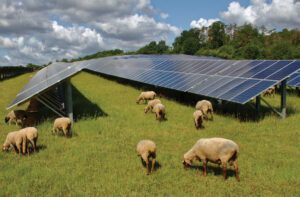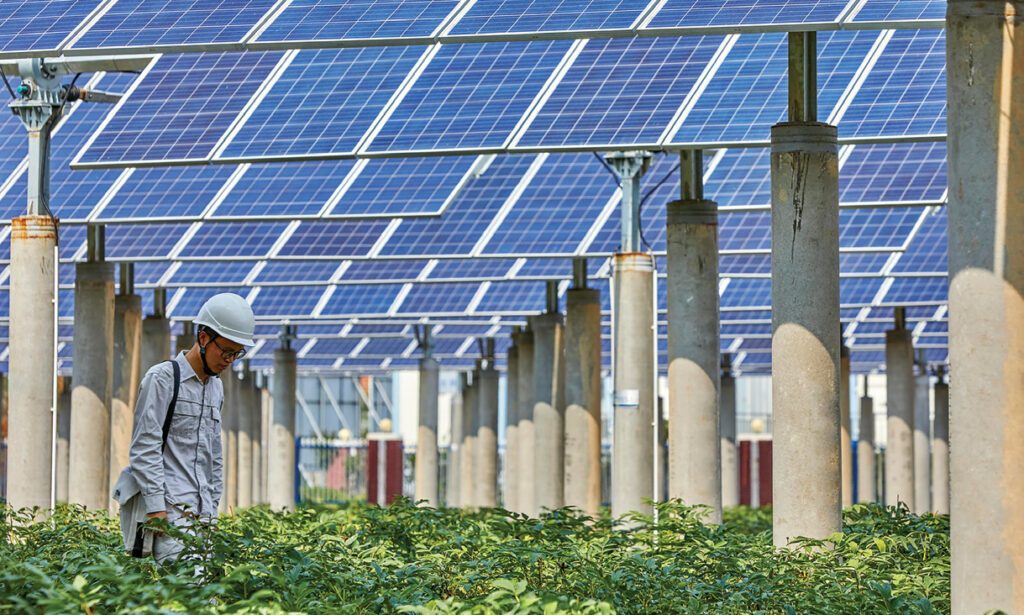Following a boom overseas, the power of the sun is about to be captured by Kiwi farmers. By Delwyn Dickey.
Coming late to the party with energy generated from solar farming could give New Zealand the opportunity to avoid some issues that have cropped up overseas, and integrate the structures more smoothly into our commercial rural landscapes.
The increase in solar farms around the globe is leading to a new type of farming – agrivoltaics –running livestock, usually sheep, under the photovoltaic panels as well as cropping.
Incorporating farming operations under the panels is being seen more often and is becoming a stipulation for more local body resource consents. In countries like Japan, with limited land, they now go hand-in-hand with 120 different crops grown under the panels.
There is much to appreciate as the photovoltaic panels silently harvest energy from the sun and pump it into national grids, as the world moves toward a zero carbon future. But they have also come in for criticism from some farmers and environmentalists. Some large utility solar farms overseas have been described as ecological wastelands, with spraying or mowing to keep weeds down and little biodiversity going on under them. Placing them on undeveloped land has seen the shading damaging native ecosystems.
The preferred option is to put the solar farms on ‘brownfields’ – previously developed land that is underused like old mining areas or has issues with toxic residue from industry.

Possibly the most famous is a 1MW plant developed by Solar Chernobyl, just 100 metres from the giant metal dome sealing the remains of the nuclear power plant which suffered a catastrophic meltdown in 1986.
Radiation contamination means land in the area can’t be used for agriculture, and there are plans to expand the operation to 100MW.
But good quality agricultural land falling out of production has been one of the biggest bugbears of local rural communities as arrays have been built in the countryside.
The best places to site solar are often the best places for farming. Flat land close to urban areas which can hook into transmission networks.
Incorporating farming under the panels could be a win-win.
Solar panels operate better in cooler conditions – one of the most efficient is a floating array that sits on an alpine lake in the Swiss mountain village of Bourg-Saint-Pierre, which is 1810m above sea level.
Having crops and pasture under the panels raises moisture levels and cools the panels. Studies several years ago by the universities of Arizona and Maryland found evaporation from the crops below, kept the panels 9C cooler and increased their energy generation by 2%.
Meanwhile, the soil under the panels retains about 300% more water with crops, depending on the species, up to three times more productive with the shade, and water consumption reduced by nearly 160%.
Sheep also appreciate the shade and are able to graze areas it would be hard for mowers to reach.
This coexistence has seen the rise of solar grazers – sheep farmers whose whole operation consists of running flocks under the panels often on multiple solar farms. In the United States they have their own association. But the big power companies aren’t the only ones interested in solar arrays.
While about 35% of generated power globally comes from big solar farms, owned and operated by commercial power companies, the rest are smaller community and private use installations.
While 12 of the large utility scale systems in Australia use grazing under panels, says Karin Stark director of Farm Renewables Consulting, many more farmers are using solar to help keep their own costs down, running sheep under their own arrays.
“It’s all sheep grazing, Merinos in particular seem to go well with solar,” she says.
“There haven’t been many cropping systems under solar panel trials in Australia yet, but AgVic (Agriculture Victoria) is doing a pear orchard trial which should be interesting.”
Australia’s largest solar/diesel irrigation pump was installed on Karin’s New South Wales farm, in 2018. Along with running a Renewables in Ag conference each year Karin is also part of a consortium led by the Queensland Farmers Federation, investigating how microgrids can benefit agriculture as part of a federally funded project.
Panels must be higher for cattle
Running cattle under solar is still largely at a research stage. The panels have to be higher off the ground and more robust. Not just because cattle are much bigger animals and like to rub on structures, but also higher panels are exposed to higher winds.
Designing systems specifically with agrivoltaics in mind – both livestock and cropping – is behind solar energy startup Wynergy, at Tamworth, NSW.
This sees rows widened from 5-6m to 10-12m to allow for ease of movement and machinery, with panels raised from 1.2-1.5m up to 2.2m, founder Ben Wynn advises.
System components come from United States company Nextracker, and Soltec in Spain.
Ben has designed a system locally that sees cattle running under panels used to power irrigation.
Irrigation is one of the areas Canterbury-based start-up Solagri Energy will also be looking at in the future, managing director Peter Saunders says.
The company is looking at a production system specifically aimed at reducing power costs, and continuity of electricity supply, to dairy farm milking sheds.
They’ve just finished an 18-month pilot on Canterbury dairy farmer Richard Stalker’s dairy shed to prove the concept.
While cattle, goats and horses couldn’t be run under the panels, one of Richard’s farm workers ran ewes under the array periodically, he says.
Planting alyssum (gardeners may recognise these white flowered plants) or other low-growing plants that will attract bees, but also reflect light up under the panels, is one thing they have in mind.
“We are using bifacial panels which will absorb light from underneath and generate a little more electricity from that,” he says.
They are dealing straight with the manufacturers for their arrays including buying their panels from Jinko Solar in China.
“The technology is advanced, but the model is pretty simple,” says Peter. “Farmers provide us with a small parcel of land, about a quarter of a hectare, where we build the solar array.
In return, they receive solar electricity generated on their own farm at a fixed price for 20 years. There is zero capital cost to the farmer, any unused power will supply the local grid.”
“Solar arrays in our rural networks will improve onfarm economics and network resilience. It will help farmers prepare for the electric vehicle future and contribute to NZ’s zero-carbon goals,” Peter says.
Ten Canterbury dairy farmers have already signed up with installation of the first array planned to go in the ground in April, he says.

Ultimately Peter expects to have a community of farmers in each of the main dairy areas of the country. A recently approved grant from Callaghan Innovation will also help them develop a battery energy management system which they hope to have up and running within 18 months. This will see battery power kick in seamlessly if the power goes off – no more cups falling off cows or unfinished milkings.
Future projects include working with irrigation.
Like Karin’s set-up in NSW, high electricity demands of irrigation systems relying on pumping in Canterbury, mostly south of the Rakaia River is an area Peter sees a real need for solar.
“They’ve got a real problem,” he says. “The networks struggle during the summer months to provide enough electricity for some of the bigger pumps. It’s costing farmers a lot more to run those pumps because of that.”
The first solar park was installed in California in 1982 with an output of 1 megawatt (MW) – enough to power about 160 homes. There are now more than 9000 around the world producing over 4MW with the biggest single park producing over 1170MW, although clusters of parks around access points into energy networks can produce much more than that.
Panels aren’t forever
Land used for solar farms isn’t lost forever, rather land leases generally last between 20 to 30 years. At the end of that time the infrastructure can be removed or new panels put in place.
The panels are still operating at 85% capacity after 20-25 years. While they will still have 10 or so years of life left in them, from a commercial perspective they have reached the end of their productive life.
Todd Corporation – think natural gas – is behind the Kapuni Solar Power Plant opening last year in South Taranaki. Built by Sunergise the 5800 photovoltaic (PV) panels can produce enough electricity to power 500 homes. They have several other plants planned. Sheep are run under their arrays.
Far North Solar Farms has built the $30 million Pukenui power station on 12 hectares on the Aupōuri Peninsula. The 32,000 panels generate 16MW — enough to power about 3000 homes, and run sheep under the panels.
The company plans on building further arrays that will have a combined output of 1000MW (1 gigawatt), in the next five to eight years.
Meridian Energy plans to build a solar farm connected to a grid-connected battery energy storage system (BESS) at least 100MW in capacity on 105 hectares next to the Marsden Point refinery, south of Whangarei. This should provide enough electricity for 15,000 households.
They also have several other solar parks planned. Running livestock is also a possibility here but not settled yet. While they don’t have a policy on use of livestock on current and future solar arrays an agrivoltaic approach will be considered.
Australian company Solar Bay is investing $100m in a 150MW array next to Christchurch Airport.
Initially covering 220ha, this first phase of Kowhai Park will provide enough power for 30,000 homes.
There is room for it to eventually expand the array along with other initiatives, like green hydrogen, including green data centres and vertical farming within the 400ha site. While still in its early stages and partners are being sought, agrivoltaics could well be part of the mix.
In northern Waikato, Waikato Solar Farms, owned by UK-based Island Green Power is going through the resource consent stage to build a $100m solar farm over 380ha leasing agricultural land from farmers in Waiterimu. This would see enough energy supplied to power up to 40,000 households. It’s uncertain if running livestock is being considered.
Lodestone Energy is looking at solar farms in five locations from Kaitaia and Dargaville, Waiotahe Valley, east of Whakatane, Whitianga, and Edgecumbe where that site will also supply power to local residents and industry including the Fonterra dairy plant.
In total they will cover 500 ha and produce enough energy to power 50,000 homes. Taking good quality farm land out of production is always going to be unpopular and dual land use will likely be an easier sell for rural people.
Ultimately how successful agrivoltaics will be in NZ may well come down to how willing energy companies are to adopt dual land use and local councils insisting on it during the consenting process.





